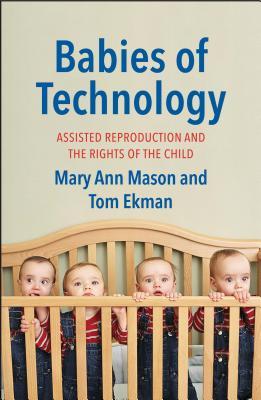Factoring in the Rights of Children in Assisted Reproduction

Babies of Technology: Assisted Reproduction and the Rights of the Child, by Mary Ann Mason and Tom Ekman, 240 pp. Yale University Press, 2017.
The preponderance of books on the assisted reproductive industry focus on the desires, experiences, and rights, loosely or legally defined, of would-be parents. In Babies of Technology: Assisted Reproduction and the Rights of the Child, authors Mary Ann Mason and Tom Ekman opt instead to survey the field from the perspective of children’s rights, using the 1989 United Nations Convention on the Rights of the Child as their benchmark.
In the opening sections, Mason, a professor emerita at the School of Social Welfare and professor and co-director of Berkeley Law’s Center, Economics and Family Security, and Ekman, a science writer, deftly cover the history and status of reproductive medicine and genetics. Then, chapter by chapter, they dive into detailed and highly topical accounts of sperm banking, egg freezing, the trade in embryos, surrogacy, and alternative family formation. Their central questions are whether current guidelines, practices, and laws respect “the right of a child to preserve his or her identity” and, “as far as possible[…]to know and be cared for by his or her parents,” as spelled out by the U.N. Convention.
Mason and Ekman find that in the U.S., the voice of the child is “almost completely missing from the law and the limited national discourse.” In the U.K. and Europe, children’s rights are more clearly articulated and protected, through policies banning such practices as anonymous gamete provision and surrogacy. But even in Europe, children’s right to citizenship is confounded by laws about offshore birth and legitimacy.
Scanning the future, the authors see risks of new forms of genetic discrimination ushered in by DNA databases, pre-implantation genetic screening, and CRISPR/Cas9. (Indeed, it seems that the future they envision has already arrived, in some regards, with the announcement on July 28 of embryo manipulations by Shoukhrat Mitalipov at Oregon Health and Science University, rendering a few of their statements already out of date.)
Imperative to protecting the rights of children, argue Mason and Ekman, are mechanisms like universal data collection on artificial insemination, egg provisioning, and surrogacy. They applaud the Donor Sibling Registry, founded by Wendy Kramer, as an example of the type of effort that needs to be extended more widely, to enable children to identify their biological heritage. They also argue that there must be true “open donor” policies, like those in Europe and Australia, that ban anonymous donation and enable children upon request to obtain the identity of the person who provided egg or sperm used in their conception.
Occasionally, the authors do focus on issues regarding consumers of reproductive technology, as when they contend that a range of changes in federal, corporate, and university polices would enable women to pursue families and continue to play productive roles in the workforce without having to go the recently ballyhooed but highly dicey egg freezing route. (Here, the authors quote Center for Genetics and Society Executive Director Marcy Darnovsky to good effect in support of such structural changes.)
In sum, Babies of Technology stands as a much-needed addition to the discussion of reproductive medicine, providing an optic that is often absent. Mason and Ekman make an excellent case for the creation of a U.S. federal agency, akin to the Human Fertilisation and Embryo Authority in the U.K., which, despite its sometimes controversial decisions, serves to regulate practices in the industry and to foster coherent national approaches to issues of identity, citizenship, and the legal standing of children. They recognize multiple advantages for children of such an oversight body, including reducing multiple births (which yield much higher rates of congenital ailments) by mandating single embryo implantation; clarifying children’s identity by recording biological and legal parents and surrogates on birth certificates; bringing greater transparency to fertility clinics; and promoting equal access to reproductive medicine.
Mason and Ekman see Europe as a model, in that the “ratification of the U.N. Convention on the Rights of Child [has had] an effect on internal laws and customs, and can provide a platform for a transformative discourse on children’s rights.” Even so, they see the time as ripe for a new U.N. Convention that would more specifically “address the rights of children of assisted reproductive technology.” Given the recent news regarding embryo editing via CRISPR/Cas9, the imperative for such an expansion of rights seems more pressing than ever.



